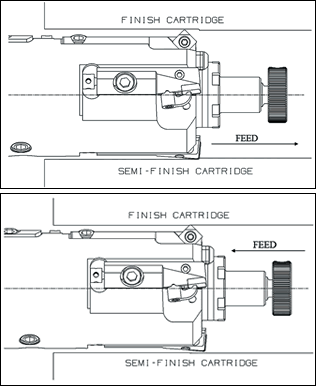Air-Actuated Boring Tool Offers In-Process Gaging
An air-actuated boring tool semi-finishes cylinders on the down stroke and finishes on the up stroke. In-process gaging compensates for tool wear to maintain bore accuracy.
Share


As engine cylinder size and finish specifications become tighter, shops are being driven to identify alternate boring methods. When cylinders are bored on a conventional machining center, two boring tools (and thus a tool change) are required for the semi-finishing and finishing operations. These tools, which are designed to cut on the down stroke inside a cylinder, can leave behind surface-marring retract marks when they back out of the cylinder. In some cases, it may not be possible to remove those marks via honing. Plus, contact with the cylinder wall during the retract stroke greatly reduces tool insert life.
For transfer line machines, a special boring tool is often used to semi-finish on the down stroke and finish on the retract stroke. Once the semi-finish stroke is completed, the machine’s spindle mechanically actuates a cartridge on the tool body that brings a finishing insert to the final bore diameter. The finishing operation occurs as the tool retracts out of the cylinder. The downside to this process is that such dedicated equipment is inherently inflexible and there often is no in-process compensation for tool wear.
Valenite LLC (Madison Heights, Michigan) has created a new boring tool that is similar in concept to this mechanically actuated design. Instead of mechanical actuation, however, the Modco Air-Actuated Cylinder Boring tool (AACB) uses compressed air delivered through the machine’s spindle to position the finishing cartridge. Post-machining cylinder measurement and automatic tool diameter adjustment allow the system to adapt to wearing inserts and repeatably deliver the 10 microns of cylindricity that engine designers often require.
The AACB has three fixed carbide inserts that semi-finish cylinders during the down stroke. A fourth finishing insert located on a spring-loaded, pivoting cartridge remains positioned below the other three inserts to ensure that it clears the cylinder wall during semi-finishing. Once semi-finishing is completed, compressed air delivered through the tool positions the finishing insert to the final diameter. Finishing occurs as the tool retracts out of the cylinder. The system requires as little as 4 bars of pressure to actuate the finishing cartridge. The cartridge is pulled back into the tool body when air pressure is removed.
The tool’s finishing diameter can be automatically adjusted within 1 micron based on cylinder measurement data. After a cylinder is bored and measured, the tool is positioned near a gripper installed either on the machine or workholding fixture. The gripper holds an adjustment knob located on the end of the AACB as the machine’s spindle rotates to adjust final diameter. In-process diameter adjustment not only helps deliver consistently accurate bores, but also eliminates the need to change an insert before its useful life is reached (a common yet costly practice to ensure bore accuracy). Automatic adjustment for wear maximizes the number of operations per insert and reduces tooling costs. This method of using a mechanical knob and gripper control via CNC and gaging was developed in partnership with the MAG Industrial Automation (Sterling Heights, Michigan).
Versions of this tool are available to bore cylinders ranging in diameter from 8 to 300 mm. The company is developing other boring tool versions that use through-spindle coolant to actuate the finishing cartridge.
Related Content
Measuring Torque, Thrust Force for Smart Drilling Operations
To monitor drilling operations for smart manufacturing solutions, torque and thrust force can be measured.
Read MoreA New Frontier in Surface Finish Control
What if your machine tool could measure surface roughness as it cuts? This article explores how in-process metrology is advancing from concept to reality, enabling real-time feedback, immediate detection of anomalies and new levels of control over surface quality. Discover the technologies making this possible.
Read MoreMaximizing Milling Operations With the Right Cutter
Selecting milling cutters that are suited to the task at hand can reduce cycle times, improve part quality and save money. Here’s where three milling cutters excel.
Read More


























